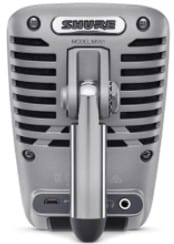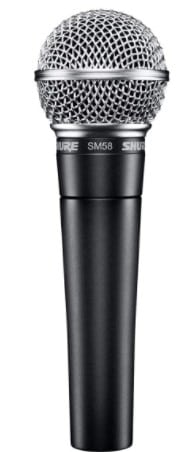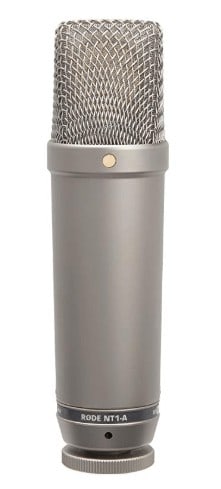If you love singing with iPhone or Android then you would have certainly come across the Smule app.
To make your singing sound superior today we are reviewing the 5 best mics to use with the Smule app.
# | Product | Frequency response | Amazon product page |
1 | Shure MV51 - Our Best Pick | 20Hz-20kHz | |
2 | Samson Go Mic - Budget Friendly Pick | 20Hz-20kHz | |
3 | 20Hz-20kHz 20Hz-20kHz | ||
4 | 20Hz-20kHz | ||
5 | 30Hz-15kHz | ||
6 | 20Hz – 20kHz ±3dB | ||
7 | 30 – 15,000 Hz |
Hooking a mic up to your phone for recording was only stuff of dreams years ago. Today, not only can you connect a mic to your smartphone, you can record guitars, and even have a song made with just your iPhone or Android.
If you are a great fan of iPhone videography too, I recommend you to use external mics to get an extremely good sound.
The Smule app has made millions of people all over the world record their songs, share their song ideas and even collaborate, all with their smartphones. Apart from singing over smartphones, if you love voice overs you can check our post to get the best voice over mics.
If you're one of those people, you've probably noticed that the in-built mic in your phone cannot produce satisfying results when you're recording; and don't even think about using the ones on your earphones, those are only good for phone calls.
So, whether you're simply having fun with the Smule singing app, or you're actually trying to get your talent noticed, you should consider using an external mic for recording yourself.
What is Smule and how to set it up?
Smule is a hugely popular karaoke social app. It allows people to record themselves singing and performing along to various songs and upload their content to the community. Also, the community members can collaborate with each other from anywhere in the world, by performing the same song.
Once registered, you can add filters and effects to your audio and video to give your content an exciting outlook.
Why do you need pop filters for Smule?
If you want to be considered a "pro singer" on Smule, you must take care of your vocal recordings quality. One of the common issues users have is the "pop" sound in their recordings. With most mics, you hear these pop sounds when making plosive sounds like "p", "b", and so on.
To avoid this, you should add a pop filter in front of your mic. An alternative is to ange the mic such that the air from your mouth does not hit it directly. Of course, this will affect the sound quality.
What to look at while buying mics for Smule?
Compatibility
Before picking a mic for Smule, you must be sure that it's compatible with your device, either iOS or Android. If you like a mic but it does not seem compatible, you can also check if there is an adapter or third-party device you can use to achieve the connection.
For example, you can connect XLR mics to your iOS or Android by using the iRig Pre HD. You can also connect your USB mic to your Android by using an OTG adapter to convert the USB to micro USB or Type C USB.
Polar pattern
The best polar pattern for Smule singing is cardioid. This is because it will capture what's right in front of the mic and reject other sounds to an extent. You will need this especially if you're not recording in a very quiet environment.
Here are our 7 best Mics for Smule singing app
#1. Shure MV51 – Our best pick
Build and design
Specifications
- Frequency response – 20 Hz to 20KHz
- Polar pattern – Unidirectional (Cardioid)
- Maximum SPL – 130 dB
- Cartridge Type
Electret Condenser (16 mm) - Sampling rate – 44.1/48 kHz
- Adjustable gain range – 0 to 36 dB
The Shure MV51 is a desktop USB mic that can connect directly to your phone. It comes with a USB port and lightning and USB cables, for your computer and iPhone.
If you want to connect the MV5 to your Android, simply get an OTG device. It converts the regular USB to micro USB or USB – C for your phone.
The Shure MV5 gives you more flexibility than some of the more sophisticated mic options. With the headphone jack, you can monitor what you're singing in real-time.
The design is cute, and will fit in most Smule performance videos.
Sound quality
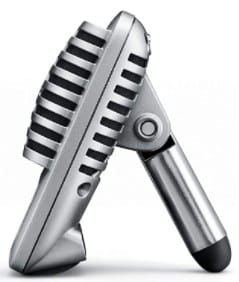
The MV51 has a built-in DSP that processes your voice to avoid distortions due to high volume. Test the five options available to see what suits you best. You can choose among Speech, Singing, Acoustic Instrument and Loud. The last option is Flat, which means no processing.
You can mute the headphone monitoring and adjust the volume. The controls on this mic are touch-sensitive.
Pros:
- The Shure MV51 is easy to set up, all you need is to plug it into your phone.
- It is a great choice if you're on a budget, plus you don't need to spend on extra devices (except OTG which is super cheap).
- The headphone jack enables you to listen to yourself as you record or stream.
Cons:
- The mic stand is short, so you may need to raise it especially if you're a tall person.
- The controls are touch sensitive, so you may accidentally trigger them sometimes.
#2. Samson Go Mic – Budget-friendly pick
Build and design
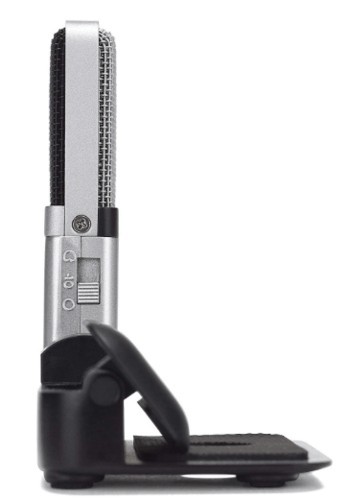
Specifications
- Element Type: 2 x Electret condenser
- Polar Patterns: Cardioid and Omnidirectional
- Bit Depth: 16-bit
- Sampling Rate: 44.1kHz / 48kHz
- Maximum SPL: 121 dB
- Sensitivity: -47 +/- 2 dB/Pa
The Samson Go Mic is a very compact, sleek 70.5 x 43.5 x 23mm USB microphone. The recording head of the mic is about half of the whole body, as shown by the space taken by the metal grille.
The switch on the side allows you to select among the cardioid polar pattern, omnidirectional polar pattern and the cardioid pattern with a 10db pad.
If you're recording into Smule by yourself, then you should select the cardioid pattern, or you can add the 10db pad if you notice you're a bit loud and close to the mic.
On the other hand, if you wish to record with a couple of friends or even a group in a room, you can switch to the omnidirectional option. This allows the mic to pick up sound from all angles.

Like a good USB compliant microphone, it needs no third party equipment or driver. Once you hook it up, you're ready to go.It also has a ⅛" headphone jack on the side; no monitor gain control though.
Sound quality
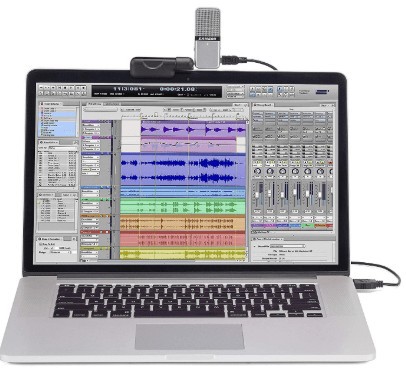
When the Samson Go Mic is in cardioid polar pattern, its frequency range is 80Hz to 18000Hz; but when it's in omnidirectional, the frequency response widens to 20Hz to 20000Hz. Now, this makes a lot of sense.
Here's how:
When the mic is in cardioid mode, it's because you're probably the only one recording at the moment.

The mic records only what's in front of it, but at the same time, it can be prone to bass buildup due to proximity effect.
However, in this case, this bass build up will not occur because the lowest frequency possible has been raised to 80Hz. For Smule recording, I think that's good enough.
Also, one of the good things about omnidirectional mics is that they're almost immune to proximity effect, so when it's in Omni mode, even though the frequency range extends to 20Hz, the bass buildup is not an issue.
Pros:
- Compact and portable design
- Immune to proximity effect
Cons:
- No gain control for headphone monitoring
#3. Shure SM58 – Excellent noise rejection
Specifications:
- Connector Type – XLR Connector
- Number of Batteries – 1 Lithium ion batteries required.
- Polar Pattern – Unidirectional
- Item Weight – 499 Grams
- Number of Channels – 1
- Frequency Range – 50 hz – 15 khz
Build and design
The Shure SM 58 is a dynamic mic that you can use with the Smule singing app. To connect it to your phone, you need the IK Multimedia iRig Pre HD. The SM58 itself can only be connected through its XLR port.
Also, this mic's design is what you expect to see in a performer's hand at a concert. So, if you will upload videos of your Smule performances, this mic's design will fit right into it.
That's not all. This handheld dynamic mic has a rugged build that can withstand a few drops without being damaged.
Sound quality
Being a dynamic mic the Shure SM58 does a great job of rejecting background noises. If your room is not too quiet, this can be a good solution for you.
It's a professional-grade mic that ensures that you send quality audio into the app for processing, recording, or streaming.
If you need a handheld mic that makes your Smule performance look and sound professional, the SM58 is a great choice.
Pros
- The SM58 has a solid build that makes it durable.
- It is a dynamic mic, so even loud volume recording does not make the sound distort.
- This handheld mc is great at rejecting unwanted background noise.
Cons
- It can't record more than one person at once.
- You need to purchase the iRig pre HD to make it work with the Smule app on your phone.
#4. Rode NT1A – Highly sensitive mic
Specifications:
- Connector Type – XLR Connector
- Connectivity Technology – Wired
- Power Source – AC
- Audio Sensitivity – 5 dB
- Polar Pattern – Unidirectional
- Item Weight – 4.6 Pounds
- Impedance – 100 Ohm
Build and design
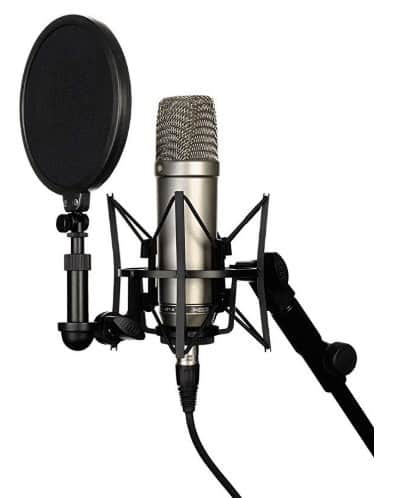
Rode NT1A is a condenser mic that is popular among professional singers, producers, and recording engineers. However, like the SM58, you need the iRig Pre HD to hook this mic up to your computer or phone. It only has an XLR port, which is absent in your phone.
Also, the NT1A needs 48V of phantom power to work effectively. If you're using the iRig Pre HD, all you have to do is switch on the phantom power control.
Sound quality
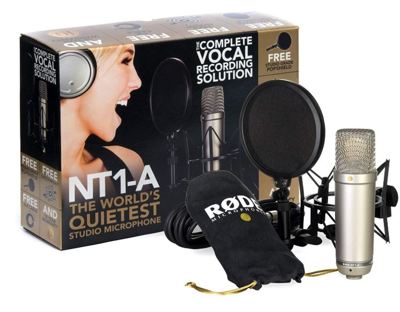
It is a highly sensitive mic that captures even quieter sounds. So, you need to be in a quiet environment to make this work.
Also, it captures a rich tone, so you can be sure that your voice's richness across all the frequencies will be recorded. It has a wider range than Shure SM 58.
Lastly, the Rode NT1A has a neutral response, so it does not enhance any parts of your voice. This means that Smule gets audio that is close to the original. So, you can be sure that any changes you hear are from the app's processing.
If you have a quiet recording space and you need professional sound, then Rode NT1A is one of the mics you should consider.
Pros
- Rode NT1A captures the full richness of tone in your voice.
- It has a high SPL, so the sound will not distort when you sing loudly.
- This mic is a professional-grade mic that gives you quality pro-sound.
Cons
- You need an added unit – like the iRig pre HD to supply the phantom power you need, and to connect to your phone.
- Because of its high sensitivity and low self-noise, this mic may capture some background noise while you're singing.
#5. iRig Mic Handheld Condenser Mic
Build and design

Specifications
- Frequency Response: 100 Hz – 15 kHz
- Mic type – Condenser
- Application – Vocal & field recording
- Recording quality – 16-bit, 48 kHz max
- Connection – 1/8" TRRS
- Maximum SPL – 133 dB
The iRig Mic is a handheld dynamic microphone, which connects to your phone via the ⅛" jack output.
It's built like a regular handheld stage mic, so you can easily hold it and feel like a popstar while recording on Smule (and hopefully sound like one too).
The mic has a gain boost/reduction switch on it. There are no numbers on to indicate exactly how much gain you're adding or removing, there is just a symbol to indicate which side goes higher and which one goes lower.
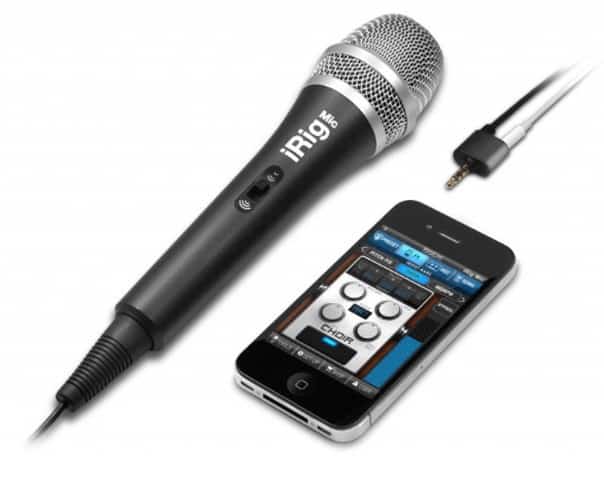
Moving further down the mic's body, you'll notice that the cable is not detachable, and it ends in a ⅛" jack that you'll connect into your phone. The good thing about this kind of connection is the opportunity to power your phone while recording at the same time.
Sound quality

On the connecting jack, there is an additional port for monitoring the sound being recorded. This one gets a little tricky because the monitoring is dependent on the app and your phone's performance.
This means that you may experience some latency in monitoring, depending on how well these two factors work together. Also, the gain switch on the microphone is primarily for the input into your phone, not for monitoring.
The frequency response is relatively quite flat, which is unexpected for a plug and play mic.
Don't get me wrong;
It's good to have a flat response if you're doing a professional recording. But for Smule recording, you want your vocal presence to be a bit emphasized.
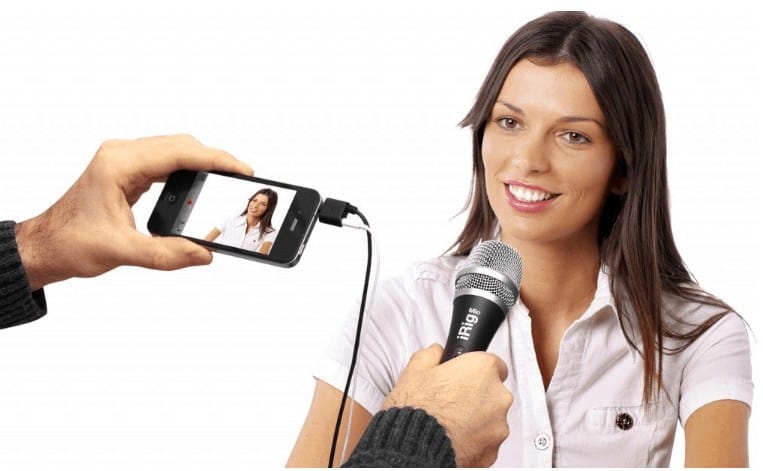
Another issue I had with the iRig Mic is the plosives and sibilance. Without a pop filter, you get recording littered with pops and hisses here and there.
If you don't have a pop filter you can get around this by placing the mic a bit to the side of your lips while recording, so that the air doesn't go indirectly.
Pros:
- Allows charging of phone while recording.
- Deals with off-axis noise quite well
Cons:
- Poor handling of plosives
- Undetachable cord may be an issue of damage.
#6. iRig Mic Studio Digital Studio Microphone
Build and design:
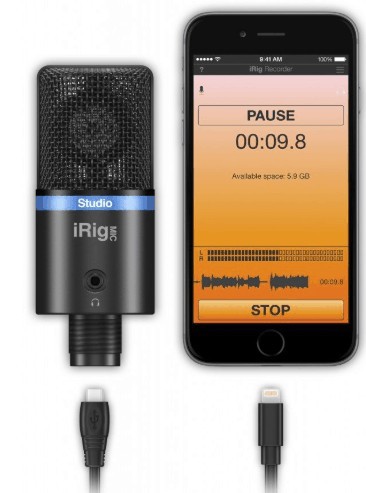
Specifications
- Type: Large diaphragm, back electret 1" condenser capsule
- Polar pattern: Cardioid
- Diaphragm: 3μm Nickel sputtered
- Resolution & Sample Rate: 24 bit, 44.1kHz / 48kHz
- Freq. response: 20Hz – 20kHz ±3dB
- Gain range: 40dB
The iRig Mic Studio has a solid build, with a grille and the rest of its body made of metal. It is quite light, which makes it a good choice if you wish to move around with your mic. There are two knobs on the iRig Mic Studio.
The first is a gain knob that controls the input signal that enters your phone, while the other is the headphone monitoring level control knob.
Between these two knobs, you'll find an LED bulb that indicates when you have signals and when there's clipping. On the back of the microphone, there's a 3.5mm headphone port for monitoring your recording.
Additionally, Mic Studio is a cardioid condenser microphone, connected and powered via a standard micro USB port. It's also a plug and play device, which means that the Smule app is enough to get it working smoothly with your iPhone or Android.
Sound quality

What we first notice with the iRig Mic Studio is the latency present when monitoring via headphones. I didn't really expect this to happen since the headphone monitor was routed straight from the mic and not through the phone.
However, the mic does pretty well with off-axis rejection, which can be very useful if you're recording in a not-so-quiet area.
You don't really need to see the frequency curve of this mic before you know it's a u-shaped curve. The dip in the mid frequencies and the increase in the lower and higher frequencies are quite audible.

At times, your vocals may sound slightly harsh, especially if you already have a high-pitched voice.
This may work well for people whose voices naturally have a lot of warmth and body. If you have such a voice, just make sure you are not too close to the mic while recording, or the low-frequency boom will overshadow your singing.
Pros:
- Solid build
- Hands-on gain control
- Portable size and weight
Cons:
- Latency present in the monitoring
- High pitched vocals may sound harsh.
#7. Audio-Technica ATR2500 – Our best pick
Build and design
Specifications
- Mic type – Condenser
- Polar Pattern: Cardioid
- Frequency Response: 30 – 15,000 Hz
- Power Requirements: USB Power (5V DC)
- Bit Depth: 16 bit
- Sample Rate: 44.1 kHz/48 kHz
- Weight: 366 g (12.9 oz)
The Audio Technica ATR2500 is a USB mic that connects straight to your iPhone or Android. All you need is the right connecting cord. You don't need any audio interface to hook it up.
All you need is an adaptor that can convert the regular USB plug to iPhone and android compatible ones.
Once you have it hooked up, all you need is an app that would recognize the mic. In this case, it's the Smule singing app. Once the mic is connected it shows a blue LED light.
The ATR2500 has a ⅛" headphone jack output on it for monitoring sounds, two switches to increase and decrease the monitoring gain. Note that the controls do not affect the recorded material, just the one you're monitoring with headphones.
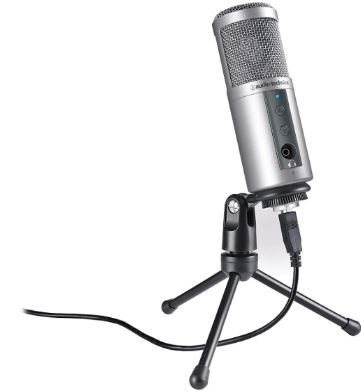
If you're using this mic with Smule, you may not have to worry about a pop filter, because the ATR2500 has an inbuilt windscreen that prevents plosives and sibilance from getting into your recording. Its body is all metal; looks pretty solid and durable.
Sound quality
Vocals recorded with the ATR has somebody to it, due to a slight lift around 4kHz to 8kHz. The response only goes down from there.
With the frequency range at 30Hz to 15000Hz, you can see why it doesn't sound so bright.
It's a cardioid condenser, so it records mostly just what's in front of it. There's a slight bump in the lower end of the frequency range, around 30-50Hz. While this may help singers with light voices.
It may also add to the proximity effect you will experience, especially if your voice is quite deep. A way to deal with this is to move away from the mic a bit, so you don't get your recording all muddy.
Sometimes you want to sing into the Smule app with your guitar. If you're using this mic, you must be careful with the placement, your guitar may sound a little muddy, with too much bass.
Pros:
- Good for singers with thin voices
- Has an in-built pop filter
Cons:
- Lacks enough brightness
- Prone to proximity effect
FAQs on Smule microphones
If you're using an iPhone, you can either use a 3.5mm mic or lightning mic. For Android, its 3.5mm, micro USB or USB-C microphone. Just connect it to the appropriate port on your phone.
Check if you're using a correct adapter to make the mic compatible with your phone. Even though an adapter connects the mic to your phone, it may not transfer the audio.
Just make sure you get the address end of the mic right. Also, mount the mic such that it's not shaking when you're recording. The handling noise may mess things up.
It's better to record with headphones, especially when you're doing multitrack recording or using an instrumental. It's really the only practical way.
One group is not essentially better than the other, but you will find more budget condenser mics that will sound great. On the other hand, a lot of cheap dynamic mics are not really that good.
Read our other popular posts:
- The Only 5 Best Microphones for iPhone/iPad Devices (These Don't Suck!)
- Top 10 Best Microphones for Voice-over and Podcasting
- 6 Best Wireless Mics for Computer Reviewed in 2023
- What is Gain on a Microphone: 3 Different Kinds Explained
- 7 Best Astatic Mics: Do These Noise Canceling Mics Sound Superior?
- 7 Best Lavalier Microphones for DSLR Cameras (Crisp Clear!)
- How to Earrape Mic? (Discord, Zoom) – Don't Miss this Guide
Conclusion
Having a decent recording has never been easier. The Smule app adds a juicy extra; getting your voice heard by people all over the world. With platforms like this, you never know how far your voice will eventually reach.
Once you've decided to get your voice heard, I think you also deserve to have an accurate representation of the voice; rather than a distorted version or shadow of your real voice.
You simply cannot achieve a correct representation of your voice on Smule with your phone's inbuilt mic. This is why an external mic is important. I hope you are now able to make an informed choice.


